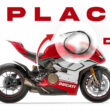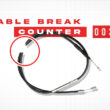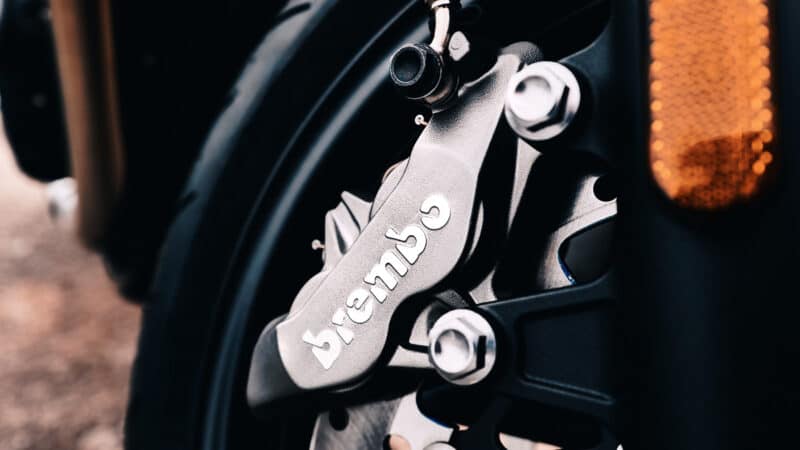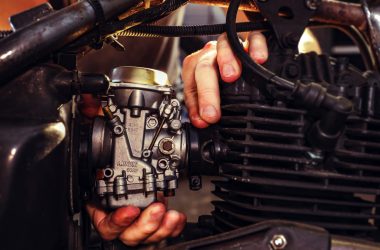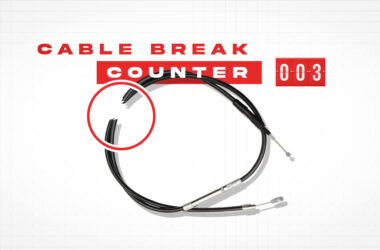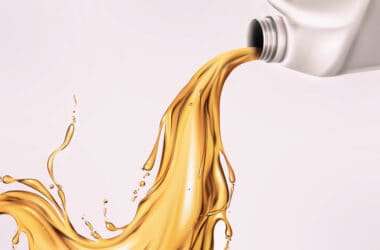Table of Contents Show
When riding motorcycles, one of the most crucial factors contributing to rider safety is the motorcycle brake pistons. Proper functioning of the caliper and its other parts is a must. Many people face problems with their brake piston not retracing, but they are unaware of why it’s happening and how to fix it.
So what is the reason for the motorcycle brake piston not retracting or getting stuck? The brake piston is not retracting due to dirt or rust build-up on the piston’s surface. Ripped or punctured brake caliper seals will also cause the brake pistons to get stuck. Dirt or dust particles should not enter the seal of brake calipers. Check out for old brake fluid as it should be replaced after 24-28 months of use. The wrong grade of ( incompatible ) brake fluid should not be used in your motorcycle.
Motorcycles that are exclusively used for off-roading purposes or in a dusty environment will face the problem of brake caliper not retracting. Worn-out brake pads from excessive hard braking can also contribute to this problem.
There is a high probability of dust entering the seal of brake calipers if the motorcycles are used in specific terrains such as ( muddy, dusty off-roads ).
The resistance of the brake pistons will increase due to dust entering the seal which won’t allow the pistons to move accurately as they are supposed, and the formation of rust is inevitable.
So if you’re buying a second-hand used motorcycle that has seen a significant amount of off-road tracks, be sure to check its braking action. See if the brakes are reactive enough to your actions.
You can also check the brake lever movements to see if it’s getting stuck or unreasonably heavy while pulling it over a few times in a row.
What Causes Brake Caliper Piston To Not Retract?
Dirt buildup on the brake caliper piston surface, damaged brake caliper seals, and wrong-grade brake fluid are the key causes for the brake caliper piston to not retract or get stuck.
Now let’s look into the details behind each of these 3 causes.
1. Accumulation Of Dirt On The Brake Caliper Pistons
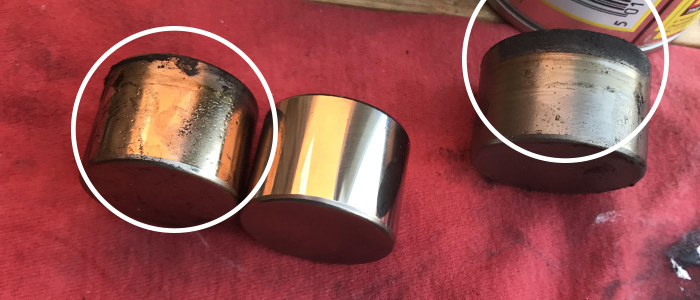
Over time small particles of dust/dirt can get inside the brake caliper’s bore where the piston is located. These particles of dust will get stuck onto the surface of the brake caliper’s pistons.
Friction will be caused and can result in the caliper pistons not retracting or getting stuck in extreme cases.
2. Punctured Or Damaged Brake Caliper Pistons Seals

Motorcycle brake calipers have a dust seal and inner compression seal. Rip or puncture to these brake caliper seals will cause the brake caliper pistons to not retract completely or get stuck.
These seals stop dust particles from getting inside the brake caliper’s bore and maintain the right amount of pressure and compression for the pistons to move efficiently.
3. Incompatible Or Wrong Grade Brake Fluid
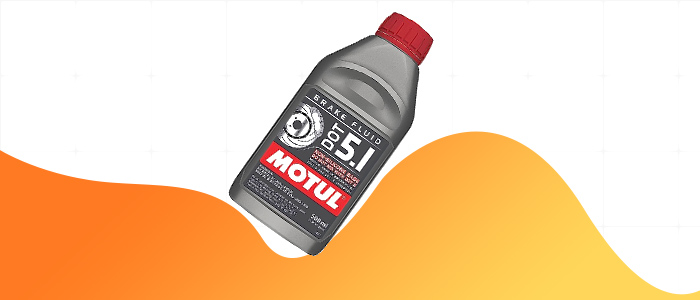
Using wrong grade of brake fluid will not lubricate the pistons properly and can cause damage to the brake caliper seals.
Continuing to use wrong grade of brake fluid in your motorcycle can cause further damage to the motorcycle’s brake line, master cylinder, and brake caliper pistons.
Refer to your motorcycle’s owner or service manual to find the right brake fluid.
How To Push Motorcycle Brake Caliper Piston That Doesn’t Retract
As we have discussed earlier in this article, why your brake pistons are not retracting? As you know by now it’s because of the dirt entering through the seal and getting accumulated around and on the piston’s surface, which creates resistance and will eventually get the pistons stuck. So now the question remains, how to push the motorcycle’s brake piston back?
To get your motorcycle pistons unstuck and to retract accurately, brake pistons should be pushed out of the caliper and thoroughly cleaned with brake cleaner or engine compartment cleaner (WD-40) and dried off with wet and dry paper. Once it’s properly cleaned, the pistons should retract back into the caliper and will be back into working condition.
Following the steps of removing the caliper from the bike and getting the brake pads off from it and also adequately fixing the pistons might seem a lot of work.
But you don’t have to worry about it. You can follow the step-by-step process in detail to get your motorcycle’s pistons back into working condition. But here’s a list of few tools you will need to carry out this process smoothly.
Motorcycle Brake Pistons Cleaner & Removal Tools
- Brake Cleaner.
- Brake Fluid ( Recommended For Your Motorcycle ).
- Wet & Dry Paper.
- Socket Wrench ( Standard Wrench If Needed ).
- Motorcycle Brake Piston Removal Tool Or Air Pressure Gun.
- Tissue Paper.
- Soft Bristle Toothbrush.
Here’s a step-by-step process of fixing pistons that are not retracting & how to push them back.
- Place your motorcycle on a stand or ( paddock stand ) and keep all the tools and essentials at a suitable reach.
- Unscrew the two bolts holding the caliper on the rotor with the help of a socket or standard wrench.
- Now unscrew the screws which are holding the brake pads on the caliper and also remove the pins. Removing the pins will get the brake pads completely off the caliper.
- To remove the pistons completely off from the cylinder, you will have to bleed your motorcycle’s brake line.
- You can use a Motorcycle brake bleeder ( Motion Pro – Mini Bleeder ) to make this task easier and hassle-free.
- Now you will have to loosen the banjo bolt on the brake line with the help of a standard wrench to relieve the pressure around the cylinder.
- After loosing up the banjo bolt, tighten it up by hand or wrench and pull the brake lever several times for the pistons to loosen up and create some room between the piston and cylinder.
- Now you can use the brake piston removal tool to remove pistons from the cylinder.
- Insert the tool’s end into the piston, which will hold on to the inside of the piston’s wall and will be easier to pull outside. Keep in mind don’t ever pull out the piston by griping the outside surface of it.
- After pulling the pistons out of the cylinder, spray brake cleaner on the other parts of the caliper and clean it with a soft-bristle toothbrush.
- Now let it dry off, or you can use regular tissue paper to clean the remaining brake cleaner and don’t leave any tissue residue inside the cylinder and other parts of the caliper.
- Be sure to check for any dirt inside the cylinder and do a thorough cleaning.
- Replace the brake caliper seals if they are damaged.
- Now clean the pistons with wet and dry paper and get the dirt off them. Check for any dirt or rust build-up on it. If the piston’s surface is severely pitted ( small holes on the surface ) you will have to replace it with new ones.
- If the pistons are in good shape apply a thin layer of recommended brake fluid on it and reinstall it in the thoroughly cleaned and dry cylinder.
- You can apply brake fluid inside the cylinder before inserting the pistons, but it’s not mandatory to do it. If you want to do it apply a thin layer of brake fluid inside the cylinder.
- Now reassemble the caliper and install it on the rotor carefully.
- Check the reservoir brake fluid level, if it’s low fill it with brake fluid at the recommended level and close it.
- Now your brake pistons will retract accurately and will not get stuck.
- Enjoy the ride with your buddies.
Alternate Method To Fix Motorcycle Brake Caliper Piston Not Retracting
Remove the brake line Completely and spray compressed air where the banjo bolt goes. This will push out the pistons from the cylinder.
Unstick or remove one piston at a time by using a c-clamp to hold another one.
Motoxtasy Pro Tip: Don’t use a grease gun to get the pistons out of the cylinder because it will create a huge mess, and you won’t be able to clean the caliper thoroughly. There will be some amount of grease left behind in the nooks and crannies of the cylinder. There might be some grease residue in the cylinder that you won’t be able to cleanout. And the brake fluid should never come in contact with other fluids. So don’t use the grease gun to get the pistons out of the motorcycle’s caliper.
Does Damaged Brake Caliper Pistons Affect Motorcycle’s Brake Pads
Piston retraction is very critical as when you take your hands off the brake lever, the piston should move back(0.5-1mm) to prevent the brake pad from rubbing on the disk.
Does Damaged brake pistons affect the motorcycle’s brake pads? Damaged brake pistons cause motorcycle brake pads to fade ( worn-out ) quickly and can cause issues like poor performance, decrease in power and torque, inefficient braking, poor mileage. And in the worst-case scenario, brakes can catch on fire.
The fundamental task of the calipers is to make an even contact between brake pads and the rotor and retract the pistons back in their original position.
If the brakes are engaged, the caliper pushes its brake pistons out of the cylinder to come in contact with the pads.
The pistons then push the brake pads onto the rotor resulting in braking. So if the brake pistons are faulty or damaged, they will get stuck. Which then will activate the brakes subtly, causing the pads to work overtime.
So replacing motorcycle brake pads should not be avoided.
There should be a gap between brake pads and rotor to function in an optimal and recommended way. So it’s crucial to inspect motorcycle brakes at the time of the service.
Conclusion
If you know that your motorcycle’s brake pistons are stuck, the formation of dirt or rust on the piston’s surface is causing it. Follow a proper brake maintenance schedule and don’t ignore this issue.
Thorough cleaning of pistons and caliper is a must to get motorcycle pistons unstuck and work accurately. Follow our step-by-step process to get your motorcycle’s pistons unstuck and retract properly.

